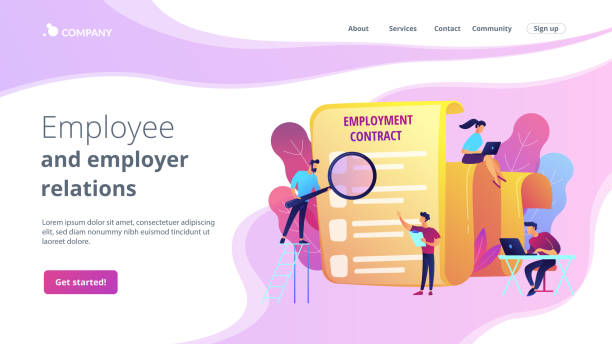An Introduction to Responsive Website Design and its Importance

In today’s world, where users access the internet from various devices, #Responsive_Website_Design or Responsive Web Design is no longer a luxury option but an undeniable necessity.
This web design approach allows websites to intelligently adapt their appearance and functionality to the screen size and orientation of the user’s device.
From desktop computers with large displays to laptops, tablets, and smartphones of various dimensions, a responsive site always provides the best user experience.
The importance of this issue is doubled when we know that a significant portion of today’s internet traffic comes from mobile devices, and users expect content to be easily accessible without the need for zooming or horizontal scrolling.
The absence of responsive design can mean losing a significant portion of the audience, reduced interactions, and consequently, a drop in conversion rates and sales.
The main goal of responsive website design is to improve accessibility and ensure that your website’s content is easily viewable and interactive without any issues.
This approach does not mean creating multiple versions of a site for each device, but rather designing a flexible site that displays correctly and optimally on all devices.
In fact, responsive website design not only improves user experience but also plays a vital role in search engine optimization (SEO), as Google and other search engines prefer responsive websites in their rankings.
This educational and explanatory article will help you gain a deeper understanding of the various aspects of responsive website design.
With the widespread use of mobile devices, the need for a website with responsive design capabilities is felt more than ever, and investing in this area is a strategic and vital decision for any online business.
Learning the principles of responsive website design is an essential skill for today’s web designers, helping them deliver projects with high stability, usability, and future-readiness.
Ultimately, discussing why responsive website design is of high importance leads us towards continuous improvement of users’ digital experience, paves the way for success in the web space, and ensures the future of online presence.
Do you dream of a thriving online store but don’t know where to start?
RasaWeb is your comprehensive e-commerce website design solution.
✅ Attractive and user-friendly design
✅ Increase sales and revenue⚡ Get free consultation
Key Principles of Responsive Design: A Detailed and Technical Review

To achieve a fully responsive website, three key technical principles must be considered in harmony, forming the core foundation of responsive website design.
The first principle is the use of Fluid Grids.
Instead of defining element widths with fixed pixels, fluid grids use relative units such as percentages or Viewport units (like vw and vh).
This means that the width of a column, a content section, or even the spacing between elements will be a function of the overall screen width.
This approach ensures that the site’s layout is displayed well and proportionately across different screen sizes without distortion, providing a seamless user experience.
This aspect of responsive website design is extremely vital and fundamental, requiring a deep understanding of how CSS works.
The second principle is the use of Flexible Images and Media.
Like grids, images and videos should not have fixed pixel dimensions that might overflow their containers on smaller devices or appear low-quality on larger displays.
By using CSS code that sets the maximum width of images to 100% (img { max-width: 100%; height: auto; }), images ensure they never extend beyond their parent container and, at the same time, shrink as needed to fit the available space.
Furthermore, using the HTML5 <picture> element and the srcset attribute allows developers to provide different versions of an image for various screen sizes and resolutions.
This feature ensures that images are optimally displayed on any device and prevents the overloading of large images on mobile devices, which significantly helps improve site loading speed.
This is a specialized and essential component in the discussion of responsive website design.
The third and perhaps most important principle is the use of Media Queries.
Media Queries are a powerful feature in CSS3 that allow web designers to apply different CSS rules based on various device characteristics, such as viewport width, height, orientation, and resolution.
For example, you can define rules that when the screen width is less than 768 pixels (e.g., for tablets and phones), the navigation menu transforms into a hamburger menu, column layouts change from horizontal to vertical, or even fonts become smaller.
This capability allows designers to optimize the user experience for every screen size, thereby creating a truly responsive website that not only looks good but also delivers flawless performance in any environment.
A deep understanding of these principles and how to implement them correctly is essential for anyone pursuing responsive website design.
This analytical approach helps improve user experience and overall website performance, making it future-ready.
Popular Tools and Frameworks in Responsive Design: Comparison and Selection

To simplify and accelerate the process of responsive website design, numerous tools and frameworks have been developed, each with its own advantages and features.
Choosing the right framework can significantly impact development speed, maintenance, and the final efficiency of the website, making it a specialized and strategic decision.
One of the most widely used and well-known frameworks is Bootstrap.
Bootstrap is a powerful, open-source front-end framework developed by Twitter.
This framework includes a 12-column grid system, pre-built UI components (such as buttons, forms, navigation bars), and JavaScript plugins that make responsive design very easy.
Due to its comprehensiveness, excellent documentation, and extensive community support, Bootstrap is highly suitable for rapid and efficient project development, especially for novice designers and developers, serving as a great guide for getting started.
Alongside Bootstrap, Foundation is another popular framework developed by ZURB.
Like Bootstrap, Foundation offers a flexible grid system and a set of UI components, but it is often favored by more advanced developers who seek greater control over the final output, due to its “Mobile-First” approach, higher customization flexibility, and smaller code footprint compared to Bootstrap.
The choice between these two depends on project requirements, the amount of code needed, and developer preferences.
For those seeking more control and minimalistic coding, CSS Grid Layout and Flexbox, which are native CSS3 features, are excellent options.
These techniques enable the creation of complex, two-dimensional (with Grid) and one-dimensional (with Flexbox) layouts in a fully responsive manner without the need for external frameworks.
In addition to frameworks, various tools exist for testing and debugging responsive website design.
Browser developer tools (such as Chrome DevTools, Firefox Developer Tools) offer the capability to simulate different devices with various sizes and resolutions, which are very useful for quick responsiveness testing and debugging CSS and JavaScript.
These tools provide real-time visualization of how the site displays in different dimensions and allow for addressing potential issues, making them an integral part of the development process.
Below, a brief comparison of the features of some of these tools is presented in a table.
The correct selection of framework and tools plays a key role in the success of responsive website design projects, and specialized and educational knowledge in this area is highly valuable.
| Feature | Bootstrap | Foundation | CSS Grid / Flexbox |
|---|---|---|---|
| Comprehensiveness (Components & Tools) | Very High | High | Medium (Layout only) |
| Customization & Flexibility | Medium (Requires overriding) | High (Designed for customization) | Full (Native CSS) |
| Learning Curve | Easy to start | Medium | Medium to High (Requires deep understanding) |
| Final Code Size | More (If not customized) | Medium | Less (Only required CSS) |
| Browser Support | Extensive | Extensive | Very good in modern browsers |
Challenges and Solutions for Responsive Website Designers

Responsive website design, despite its many advantages, is not without challenges, and web designers and developers often face various issues in implementing a fully responsive website, which require creative solutions and specialized knowledge.
One of the main challenges is optimizing content and image management.
High-quality images optimized for large displays can create heavy loads on mobile devices and significantly reduce site speed.
This not only disrupts the user experience but also negatively impacts SEO.
The solution to this problem is using Adaptive Images or Responsive Images with HTML5 features like srcset and sizes, which allow the browser to choose the most appropriate image size and resolution based on the user’s device and its display width.
Additionally, using next-generation image formats like WebP can help reduce file sizes.
Another challenge is navigation management on small devices.
Extensive and complex menus that work well on desktops occupy too much space on mobile screens, disrupting the user experience.
Common solutions include using Hamburger Menus, Dropdowns, or Off-Canvas menus that are displayed only when needed and do not occupy screen space.
Designing a simple, intuitive, and finger-friendly navigation is essential.
This aspect of responsive website design requires deep thought about information architecture and content hierarchy so that users can easily navigate the site.
Testing and Debugging across different devices is also a significant and time-consuming challenge.
With countless variations of devices, browsers, and operating systems, ensuring the correct functionality and flawless display of the site on all of them is difficult.
Using online testing tools like BrowserStack or CrossBrowserTesting, as well as leveraging built-in browser developer tools (such as mobile simulation mode in Chrome and Firefox), can facilitate this process.
These tools allow designers to see how the site renders on various devices and to identify and fix potential issues.
However, conducting tests on actual devices is also essential to uncover problems related to touch interactions and performance.
Finally, maintaining performance and site loading speed, especially on mobile devices with lower bandwidth, is a constant concern.
Code optimization (minification and concatenation of CSS and JS files), Gzip compression for server resources, using a CDN (Content Delivery Network) to reduce latency, and Lazy Loading for images and videos, which are only loaded when visible in the user’s viewport, are among the solutions that can help improve the overall performance of a responsive site.
This thought-provoking and analytical content indicates that responsive website design goes beyond merely resizing elements and requires a comprehensive and planned approach to deliver a fast, user-friendly, and accessible website across all platforms, capable of meeting modern users’ expectations.
Don’t have a corporate website yet and missing out on online opportunities? With professional corporate website design by RasaWeb,
✅ Double your business’s credibility
✅ Attract new customers
⚡ Free consultation for your corporate website!
The Impact of Responsive Design on SEO and User Experience Optimization

One of the most important reasons justifying investment in responsive website design is its positive and direct impact on SEO and User Experience (UX).
Google has repeatedly emphasized that it recommends responsive design as the best method for configuring websites for mobile and includes it in its ranking algorithms.
The main reason for this preference is that a responsive website has only one URL for each page, which helps Googlebot easily index pages and prevents duplicate content issues that might occur on separate mobile and desktop sites.
This significantly helps maintain domain authority and page power.
This is a key analysis in the field of website ranking.
Furthermore, the page loading speed factor, which is an important and growing element in Google’s ranking, directly benefits from responsive design.
By optimizing images and CSS/JS codes for different devices, responsive sites can achieve higher loading speeds, especially on mobile.
This speed improvement not only strengthens SEO and sends a positive signal to search engines but also significantly enhances the user experience.
Users who encounter delays in site loading are likely to leave the page and look for other options (increasing the Bounce Rate), which leads to a decrease in conversion rates and the loss of potential customers.
Fast sites keep users more satisfied and encourage them to stay and interact more.
From a user experience perspective, responsive websites offer a consistent and adaptable user interface across all devices.
This means users do not need to change habits or relearn how to interact with the site on different devices; menus, buttons, and forms are always in predictable locations and easy to use.
This consistency and ease of use contribute to increased user satisfaction, longer dwell time on the site, and ultimately, a higher probability of their return and conversion into loyal customers.
In fact, a positive mobile user experience can directly lead to increased brand credibility, improved online reputation, and enhanced customer loyalty.
In terms of SEO, Google adopted the Mobile-First Indexing approach years ago, meaning it considers the mobile version of your website as the primary version for indexing and ranking.
Therefore, if your site does not function correctly on mobile, has poor navigation, or slow speed, and lacks responsive website design, you virtually lose your chance for top rankings in search results.
This deep explanatory and analytical insight shows that responsive design is not merely a technical feature but a vital and indispensable strategy for a successful and competitive presence in today’s online space.
Ignoring it means missing out on countless opportunities in the digital world and can lead to falling behind competitors.
The Future of Web Design: Beyond Responsiveness with a Mobile Focus

While responsive website design has been established as the industry standard for ensuring accessibility and compatibility across various devices, the future of web design is moving beyond mere responsiveness and stepping towards mobile-first approaches and more advanced user experiences.
These developments indicate that future websites must not only be responsive but also offer more advanced capabilities to compete in the digital ecosystem.
One of the most significant developments in this area is the concept of Progressive Web Apps (PWAs).
PWAs are websites that offer native app capabilities such as offline functionality, push notifications, access to device hardware (like the camera), and installation on the device’s home screen.
This approach elevates the user experience to a new level and blurs the lines between web and app, without the need for installation from app stores.
In addition to PWAs, projects like Accelerated Mobile Pages (AMP) are also emerging, focusing on unparalleled loading speed on mobile.
AMP uses a limited and optimized set of HTML, CSS, and JavaScript to load web pages incredibly fast, which is crucial for news content and blogs where speed is paramount and users prefer quick reading.
These changes indicate that mere responsive design is not enough; rather, we must move towards websites with very high performance and app-like user experiences to meet the growing expectations of users.
This is important news in the web industry and signifies a future where speed and interactivity are paramount.
The shift in user behavior towards greater mobile device usage and their high expectations for speed and ease of access are the main drivers of these transformations.
Developers and web designers must now think beyond mere compatibility with different screen sizes and pay special attention to overall performance optimization, offline capabilities, and more advanced interactions.
This includes utilizing new browser APIs, optimizing resource loading, Microservices architecture, and providing an intuitive and efficient user interface across all platforms.
Discussions about the future of responsive website design must encompass these new trends and emerging technologies, viewing them as opportunities.
Furthermore, Artificial Intelligence (AI) and Machine Learning (ML) are gradually entering the field of web design.
These technologies can play a role in personalizing user experience, optimizing content based on user behavior, analyzing user data to improve design, and even automating design and development processes (such as design with AI-powered tools).
These developments indicate an engaging and exciting outlook for the future of web design, where websites will not only be responsive but also smart, predictive of user needs, and highly interactive.
This path shows that responsive website design will remain the foundation for these advancements, but new layers of intelligence and capability will be added to it, so that the web becomes increasingly intertwined with our daily lives.
Responsive Design in Practice: Case Studies and Success Stories
![]()
Observing successful examples of responsive website design can be the best educational tool for understanding the practical application of responsiveness principles and drawing inspiration for future projects.
Many prominent global brands and even smaller businesses, by correctly implementing this approach, have significantly improved their user experience and SEO performance, achieving tangible business results.
For instance, major news websites like The New York Times or The Guardian have been pioneers in this field.
These websites, with their vast amount of content, images, and videos, and the need to present them in diverse formats to readers on various devices (from desktops to mobiles and tablets), have leveraged responsive design in the best possible way to ensure content is easily consumable in any environment.
On these websites, column layouts, font sizes, image dimensions, and even the order of element display intelligently adapt with changes in screen size.
For example, on a large desktop display, an article might be shown with multiple columns, sidebars, and tangential advertisements, whereas on a smartphone, the same article transforms into a single column with optimized images, readable fonts, and simpler menus (often hamburger menus).
This adaptability makes content accessible to all users, regardless of their device, and prevents frustration caused by horizontal scrolling or zooming.
This is an excellent illustrative example of the effective application of responsive website design and demonstrates their strategic investment in user experience.
Another example is e-commerce websites.
Platforms like Amazon or Etsy heavily rely on responsive design to provide a seamless shopping experience across various devices, from product browsing to adding to cart and the checkout process.
This is crucial for online stores, as many purchases are now made via mobile, and the slightest user experience issue (such as small buttons or unreadable forms) can lead to customer loss.
These sites also leverage mobile capabilities like integrated payments and touch navigation, and they continuously optimize to improve conversion rates.
Portfolio websites and personal blogs are also good examples of successful responsive design implementation.
These sites often focus on visual content presentation, image galleries, and high readability, which, with responsive design, can ensure the best display on any device and showcase an individual’s artwork or writings in the best possible way.
These case studies and real-world examples demonstrate how responsive website design can contribute to business and communication goals, increase conversion rates, and maximize user satisfaction.
Below, a table outlines several key success factors in responsive design for these examples to provide an analytical view and help you understand the criteria for successful design.
| Website Type | Key Responsiveness Strategy | Impact on User Experience | Impact on SEO |
|---|---|---|---|
| News Website | Flexible column layout and fonts, hamburger menu | High readability, easy access to news on any device | Reduced bounce rate, increased dwell time |
| Online Store | Optimized product display, simple checkout process | Smooth and unobstructed shopping experience on mobile | Increased mobile conversion rate, better product search ranking |
| Personal Blog | Flexible images, larger fonts on mobile | High readability for textual and visual content | Easy sharing on mobile social networks |
| Corporate Website | Prominent CTAs, optimized contact forms | Quick access to contact information and services | Improved local ranking, increased lead generation |
Common Mistakes in Responsive Design and How to Avoid Them

Despite clear principles and tools for responsive website design, web designers and developers may make mistakes that can harm user experience and site performance.
Recognizing these mistakes and knowing how to avoid them is crucial for creating a truly responsive website and is an integral part of education in this field.
One common mistake is insufficient attention to the Mobile-First approach.
Many designers still start by focusing on desktop and then try to adapt it for mobile, whereas the correct approach is to design and develop for the smallest screen first and then scale it up for larger screens.
This key guidance helps ensure optimal performance on mobile, including speed and interactions.
Another mistake is neglecting page loading speed, especially on mobile devices.
A responsive site should not only look good on all devices but also load quickly.
Using high-volume images without optimization, heavy CSS/JS codes, multiple fonts, and numerous server requests can drastically reduce site speed.
Image optimization (compression, using modern formats like WebP), Gzip compression for all files, combining and minifying CSS and JS files, and using a CDN (Content Delivery Network) to reduce latency are vital solutions for improving speed.
This issue is particularly important on mobile networks with limited bandwidth and directly impacts user experience and SEO rankings.
Also, overly complex navigation on mobile is a common mistake.
Mobile users expect to access the information they need easily and with minimal clicks.
Nested and deep menus, small items, or closely spaced buttons that are difficult to tap with a finger (insufficient tap targets) can disrupt the user experience and lead to user confusion.
Designing simple, intuitive, and finger-friendly navigation is essential.
Use common patterns like hamburger menus, tabs, or accordions, and ensure that buttons and links are adequately sized for touch interaction.
This is an important explanation regarding mobile UX.
Another mistake is insufficient testing on real devices and relying solely on simulators.
Simulators and browser developer tools are useful, but they cannot simulate all device differences, such as network speed, actual touch interactions, hardware performance, or issues related to specific operating systems.
Testing on a wide range of real devices with different operating systems and browsers is essential to ensure correct functionality and a consistent experience.
Finally, incorrect use of Media Queries and defining inappropriate breakpoints can also lead to incomplete or disjointed site display at specific sizes.
A deep understanding of content behavior across different sizes and precise selection of breakpoints is crucial for the success of responsive website design and delivering a flawless user experience, preventing unexpected problems.
This is a precise analysis of common weaknesses in this field.
Do you dream of a thriving online store but don’t know where to start?
RasaWeb is your comprehensive e-commerce website design solution.
✅ Attractive and user-friendly design
✅ Increase sales and revenue⚡ Get free consultation
How to Order a Responsive Website for Your Business: Important Tips

Ordering responsive website design for your business is a strategic investment that requires precision, planning, and awareness of important tips to ensure project success.
The first step is to accurately define your business goals and needs.
Before any action, you must clearly know what the main purpose of your website is: Is it for selling products, providing information, lead generation, improving customer service, or a combination of these? These goals should be clearly and thoroughly communicated to the designer or development agency.
Also, having a precise understanding of your target audience and the devices they predominantly use is crucial; this information helps the design team adopt the best responsiveness strategy.
This is essential guidance for project success and aligning expectations.
The second tip is to choose an experienced and specialized team or agency in responsive design.
Carefully review their portfolio and ensure that their previous projects are truly responsive, efficient, and user-experience optimized.
Ask them questions about their approach to Mobile-First Design, the use of modern frameworks and technologies (like CSS Grid/Flexbox), speed optimization, and testing methodologies.
A specialized team should be able to provide expert consultation, guide you through the design and development process, and suggest appropriate solutions for potential challenges.
Transparency in communication and mutual understanding of expectations are key to success.
The third tip is the importance of content and User Experience (UX) design, which is often underestimated.
A responsive site is not just about visual resizing; it must optimize the user experience on every device.
Your content should be readable and accessible on mobile, and navigation should be designed to be simple, intuitive, and finger-friendly.
During the design phase, pay close attention to wireframes and mockups for different device versions and provide your feedback.
Ask the designer to show you practical examples of how content, interactions, and forms will display at various screen sizes to ensure their alignment with your business goals.
This educational approach helps you achieve the best outcome from your project and prevents problems in later stages.
Finally, pay attention to post-launch support and maintenance.
Websites require continuous updates, bug fixes, performance optimization, and adaptation to changes in browsers and devices.
Ensure that your development team provides post-delivery support and will be responsive if issues arise or changes are needed.
Also, ask them about site performance analysis after launch (such as Google Analytics and Google Search Console) and Key Performance Indicators (KPIs).
A successful responsive site is one that is continuously monitored and optimized to deliver the best experience for users and the best return for your business.
This comprehensive explanation gives you a complete overview to make an informed decision when choosing and ordering a responsive website design and maximize your investment.
Conclusion and Final Outlook on Responsive Website Design

Throughout this article, we extensively discussed the importance, principles, challenges, and solutions of responsive website design.
The main and crucial conclusion is that in the current era, where internet usage on mobile devices is rapidly increasing with unparalleled diversity, having a responsive website is no longer a competitive advantage or an additional option, but a fundamental and undeniable necessity for any business and individual aiming for an effective, sustainable, and successful online presence.
This approach not only significantly improves user experience (UX) and ensures content accessibility for all users but also plays a vital role in search engine optimization (SEO) and increasing your online visibility, which directly impacts business success.
Key principles such as fluid grids, flexible images, and Media Queries are the cornerstones of this design type, allowing websites to intelligently adapt to any screen size and provide a seamless visual and functional experience.
Challenges like optimal content management, mobile navigation, and maintaining site performance at various network speeds are also solvable and manageable with specialized approaches and the use of appropriate and up-to-date tools.
This indicates that responsive website design is a complex yet fully controllable process that, with proper knowledge and planning, achieves desired results.
The future of web design is also moving beyond mere responsiveness, towards PWAs (Progressive Web Apps), AMP (Accelerated Mobile Pages), and the use of Artificial Intelligence.
These developments mean faster, smarter websites with capabilities similar to native applications and highly personalized user experiences for each individual.
For businesses, investing in responsive website design means access to a larger mobile market, reduced bounce rates, increased conversion rates, and ultimately, sustainable growth and competitiveness in a constantly changing digital market.
Choosing a specialized team, focusing on user experience and mobile-optimized content, and planning for long-term support and maintenance are among the points to consider when commissioning such projects to ensure investment returns.
This is a comprehensive and important explanation.
The final outlook is that websites in the future must not only be responsive but also increasingly predictive and personalized for each user.
With technological advancements, it is expected that design and development processes will also become smarter, and new tools will enable the creation of unparalleled user experiences.
Therefore, responsive website design is not merely a technique but a philosophy based on accessibility and enhancing the digital experience for all users, regardless of their device, and will continue to remain the backbone of a successful online presence.
Frequently Asked Questions
| Question | Answer |
|---|---|
| What is responsive website design? | Responsive Web Design is an approach that causes a website’s design and layout to change and display optimally based on the screen size of the user’s device (computer, tablet, mobile, etc.). |
| Why is responsive design important? | Its importance is due to the increased use of various devices to access the internet. Responsive design improves user experience (UX), reduces bounce rate, and is beneficial for SEO. |
| What techniques are used in responsive design? | The main techniques include the use of Fluid Grids, Flexible Images, and Media Queries in CSS. |
| What do Fluid Grids mean? | Instead of using fixed pixel units, relative units like percentages or em are used to define the width and height of elements, so that the layout is flexible with changes in screen size. |
| What is the use of Media Queries? | Media Queries allow you to apply different CSS styles based on user device characteristics such as screen width, height, orientation (horizontal or vertical), and resolution. |
And other services of RasaWeb Advertising Agency in the field of advertising
Smart Link Building: An effective tool for user engagement through user experience customization.
Smart Conversion Rate Optimization: A new service to increase click-through rates through Google Ads management.
Smart Custom Software: A fast and efficient solution for customer acquisition with a focus on marketing automation.
Smart Content Strategy: Transform user engagement with precise audience targeting.
Smart Conversion Rate Optimization: A new service to enhance customer behavior analysis through SEO-driven content strategy.
And over hundreds of other services in the field of internet advertising, advertising consultation, and organizational solutions
Internet Advertising | Advertising Strategy | Advertorials
References
What is Responsive Website Design?The Importance of Responsive Design in the Digital FutureSmart Responsive Website DesignThe Future of Web Design and Intelligence
? Is your business ready to soar to success? RasaWeb Afarin Digital Marketing Agency, by providing comprehensive and professional services, including modern and user-friendly e-commerce website design, targeted digital marketing strategies, and specialized SEO, paves the way for your brand’s growth and brilliance.
📍 Tehran, Mirdamad Street, Next to Central Bank, Southern Kazeroun Alley, Ramin Alley, No. 6




